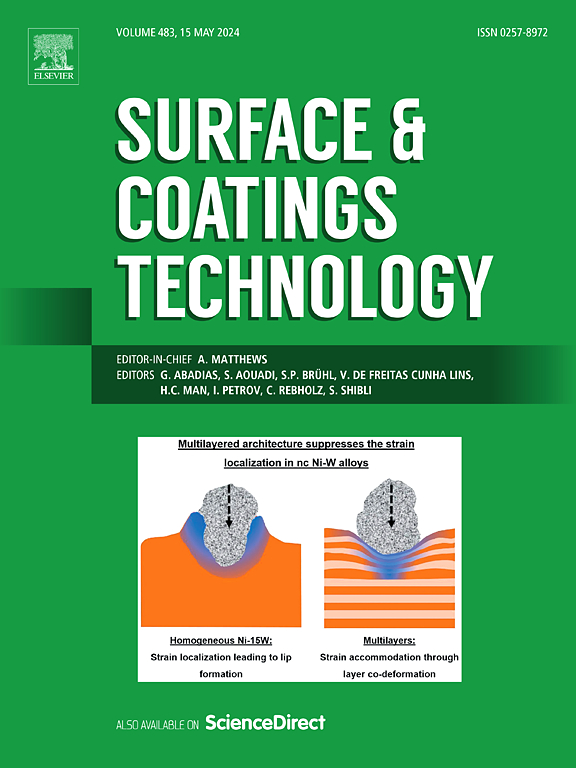TiO2对cr2o3基涂层中晶界处氢捕获和扩散的影响:实验和第一性原理研究
IF 5.3
2区 材料科学
Q1 MATERIALS SCIENCE, COATINGS & FILMS
引用次数: 0
摘要
由于氢脆,长时间暴露在氢环境中的管道寿命会大大缩短,并且存在氢致开裂的潜在风险。目前,最有效的方法是在管道内表面加装氢渗透屏障层。因此,本文采用等离子喷涂技术制备Cr2O3和Cr2O3 - 10%TiO2氢渗透屏障涂层,并结合基于密度泛函理论的第一性原理计算,深入探讨Cr2O3和TiO2对氢渗透阻力的协同作用。实验结果表明,TiO2的掺杂不仅显著提高了涂层的表面光洁度,而且有效地减少了孔隙缺陷。这种改进直接延长了氢原子穿透涂层所需的时间,降低了氢渗透电流密度,从而大大提高了涂层的氢阻隔性能。此外,第一性原理计算表明,复合涂层的抗氢渗透机理主要依赖于两个核心方面:一方面,其致密的晶体结构和稳定的化学键结构有效地阻碍了氢原子在涂层表面的吸附过程,减缓了氢原子的渗透速度;另一方面,一旦氢原子成功穿透氢渗透阻挡层内部,它们就会被涂层内的间隙和空位所困住,有效地阻止了氢原子的进一步扩散。本文章由计算机程序翻译,如有差异,请以英文原文为准。
Effect of TiO2 on hydrogen trapping and diffusion at grain boundaries in Cr2O3-based coatings: experimental and first-principles studies
The lifespan of pipelines exposed to hydrogen environments over an extended period can be significantly reduced due to hydrogen embrittlement, and there is a potential risk of hydrogen-induced cracking. Currently, the most effective method is to incorporate a hydrogen permeation barrier layer on the inner surface of the pipelines. Therefore, this paper employs plasma spraying technology to prepare Cr2O3 and Cr2O3–10%TiO2 hydrogen permeation barrier coatings and combines first-principles calculations based on density functional theory to explore in depth the synergistic effects of Cr2O3 and TiO2 on hydrogen permeation resistance. Experimental results indicate that the doping of TiO2 not only significantly enhances the surface smoothness of the coating but also effectively reduces pore defects. This improvement directly prolongs the time required for hydrogen atoms to penetrate the coating and decreases the hydrogen permeation current density, thereby greatly enhancing the hydrogen barrier performance of the coating. Furthermore, first-principles calculations reveal that the hydrogen permeation resistance mechanism of the composite coating primarily relies on two core aspects: on the one hand, its dense crystalline structure and stable chemical bond structure effectively hinder the adsorption process of hydrogen atoms on the coating surface, slowing down the permeation rate of hydrogen atoms. On the other hand, once hydrogen atoms successfully penetrate the interior of the hydrogen permeation barrier layer, they are trapped by interstitial sites and vacancies within the coating, effectively preventing further diffusion of the hydrogen atoms.
求助全文
通过发布文献求助,成功后即可免费获取论文全文。
去求助
来源期刊

Surface & Coatings Technology
工程技术-材料科学:膜
CiteScore
10.00
自引率
11.10%
发文量
921
审稿时长
19 days
期刊介绍:
Surface and Coatings Technology is an international archival journal publishing scientific papers on significant developments in surface and interface engineering to modify and improve the surface properties of materials for protection in demanding contact conditions or aggressive environments, or for enhanced functional performance. Contributions range from original scientific articles concerned with fundamental and applied aspects of research or direct applications of metallic, inorganic, organic and composite coatings, to invited reviews of current technology in specific areas. Papers submitted to this journal are expected to be in line with the following aspects in processes, and properties/performance:
A. Processes: Physical and chemical vapour deposition techniques, thermal and plasma spraying, surface modification by directed energy techniques such as ion, electron and laser beams, thermo-chemical treatment, wet chemical and electrochemical processes such as plating, sol-gel coating, anodization, plasma electrolytic oxidation, etc., but excluding painting.
B. Properties/performance: friction performance, wear resistance (e.g., abrasion, erosion, fretting, etc), corrosion and oxidation resistance, thermal protection, diffusion resistance, hydrophilicity/hydrophobicity, and properties relevant to smart materials behaviour and enhanced multifunctional performance for environmental, energy and medical applications, but excluding device aspects.
 求助内容:
求助内容: 应助结果提醒方式:
应助结果提醒方式:


